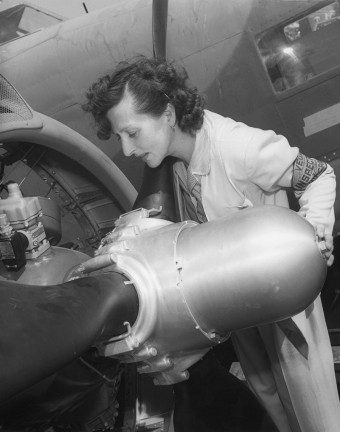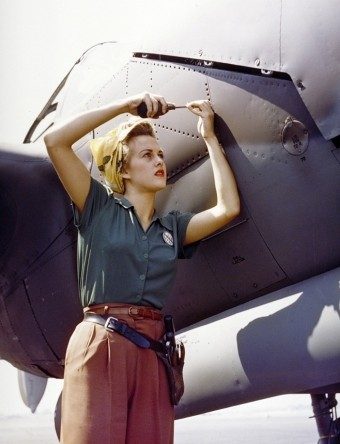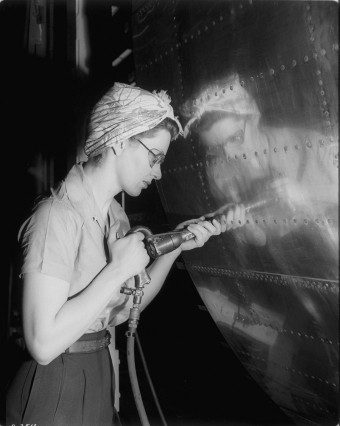Marie Calk and the 18 other women who walked into the brand-new Glenn L. Martin–Nebraska Company plant on October 20, 1941, were not looking for their place in the nation’s history books. They were looking for jobs on the Omaha-based factory floor of the sprawling B-26 bomber production facility. They found both.
The attack on Pearl Harbor was still more than six weeks away, but the demands on U.S. aircraft manufacturers to ramp up production in support of the Allied cause were already straining the labor force. A few thousand women across the industry were engaged in work on the industry’s sub-assembly periphery, yet few were on the factory floors. Lockheed counted just five women on its factory payroll prior to America’s entry into the war. Factory work, after all, was presumed to be a man’s job.

“Employment Experiment”
Glenn Martin—and within a few months the leaders of Lockheed and other aircraft manufacturers as well —realized that times had to change if the United States was going to meet the demands of wartime production. Once men started shipping off to war, there simply weren’t going to be enough male hands on factory floors to do the job. Martin pointed out to doubters of his “employment experiment”—and there were many—that women were perfectly suited to handle most of the 25,000 parts that comprised a B-26, not to mention the miles of wiring that needed to be snaked through harnesses and other work in close quarters. “Big airplanes are made up of small parts,” Lockheed executive Courtland Gross added, “and women build small parts to perfection.”
As for the jobs that required plenty of muscle, the Martin plant was already reengineering many of them to speed assembly. In fact, the government brought in auto companies as partners precisely to bring the aircraft industry up to the mass production standards of the auto industry—which it quickly exceeded. Additional hydraulic lifts, smaller rivet guns, and other tools quickly put women on an equal footing with their male counterparts.
With America at war as of December 1941, the key labor issue was how quickly women could be trained and put on the assembly lines. Newspapers across the country carried the story of sixty Pearl Harbor widows who responded to job offers at the Lockheed and Vega Aircraft plants in Burbank, California, in late January 1942, just weeks after the attack. Their motto raised the employment stakes for the industry, and the country: “Keep ’em flying to avenge our husbands’ deaths.”

“Women’s Feeling That They Could Be Something More”
Ever-escalating demand for wartime labor opened factory doors to women of all backgrounds. Housewives who had never worked outside the home and single girls fresh out of high school were sent into newly created training courses to learn the basics of riveting—often the first job offered women— welding and other jobs. Daycare centers were built adjacent to many factories so mothers with small children could pitch in and help with the war effort. Lockheed opened plants manufacturing aircraft parts in Santa Barbara, Bakersfield and Fresno in part to attract smaller town and suburban women workers who weren’t accustomed to traveling into the city.
Jobs at Lockheed and Martin gave a generation of women a newfound sense of accomplishment. They were doing their part to defend the country, and they were proving their worth in the workplace. Sybil Lewis, an African-American riveter for Lockheed in Los Angeles, explained the importance of this sea change in employment: “You came out to California, put on your pants and took your lunch pail to a man’s job. This was the beginning of women’s feeling that they could be something more.”[1]
Just six months after that first group of women walked into the Nebraska plant, more than 2,000 women were working in Martin plants in Omaha and Baltimore. By the fall of 1942, the aircraft industry as a whole had added 63,000 women to its roster, mostly in aircraft assembly plants. By November 1943, aircraft industry employment peaked at 2.1 million workers, with more than 486,000 women accounting for an astounding 37 percent of the industry labor force.

“Rosie the Riveter”
American popular culture reflected the changing face of the wartime workplace, and Rosie the Riveter was born. Although plenty of factory-floor Rosies were identified by an eager press, there was no single original model for the popular image. Rosie made an early appearance in the popular 1943 song “Rosie the Riveter” (“She’s making history, working for victory, Rosie the Riveter”).
Rosie truly captured the nation’s imagination later that spring when the Saturday Evening Post’s Memorial Day weekend issue carried Norman Rockwell’s iconic image of a female riveter with “Rosie” painted on her lunchbox cover.
After the war, most women left their factory jobs as men in returned to the workforce. But their role in supporting the war effort was not forgotten. Nor was their role for the advancement of women in the workplace at large, and within Lockheed Martin itself.
Delores “Dee” Parker was inspired by her mother, Marie Calk, both as a pioneering factory worker at the Martin plant in Omaha and as a counselor for younger working women. A half-century later, Dee was one of the hundreds of women who worked in Orlando on Apache helicopter’s target identification and pilot night vision system. Marie’s legacy also lives on in the careers of Linda Gooden, Marillyn Hewson, and Joanne Maguire – women who, as Executive Vice Presidents of Lockheed Martin, lead three of the corporation’s four business areas. They are following in the footsteps of women like Marie Calk and Sybil Lewis, who blazed trails for women across the modern aerospace industry.
1 Rosie the Riveter: Real Women Workers in World War II,” The Library of Congress.




